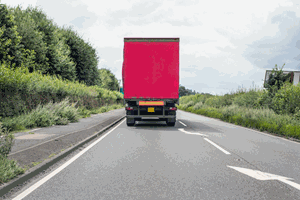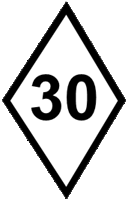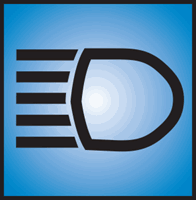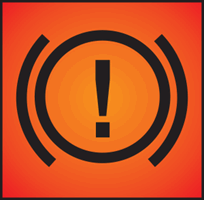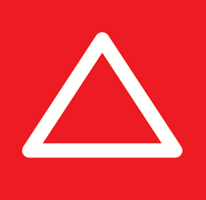There are 39 driving theory test Attitude questions. You must get 86% (34 out of 39) to pass the test. You may review answers after each question by clicking the 'check answer' button or you can wait until the end of the test for your final score. Good luck!
Test Quick View
Click on an answer to view the correct choice along with the explanation.
Correct Answer: A
Explanation: Pelican crossings are signal-controlled crossings operated by pedestrians. Push-button controls change the signals. Pelican crossings have no red-and-amber stage before green; instead, they have a flashing amber light. This means you must give way to pedestrians who are on the crossing but if the crossing is clear you can continue.
Explanation: Pelican crossings are signal-controlled crossings operated by pedestrians. Push-button controls change the signals. Pelican crossings have no red-and-amber stage before green; instead, they have a flashing amber light. This means you must give way to pedestrians who are on the crossing but if the crossing is clear you can continue.
Correct Answer: A
Explanation: If people are waiting to use a pedestrian crossing, slow down and be prepared to stop. Don't wave them across the road, because another driver may not have seen them, may not have seen your signal, and may not be able to stop safely.
Explanation: If people are waiting to use a pedestrian crossing, slow down and be prepared to stop. Don't wave them across the road, because another driver may not have seen them, may not have seen your signal, and may not be able to stop safely.
Correct Answer: D
Explanation: Tailgating' is the term used when a driver or rider follows the vehicle in front too closely. It's dangerous because it restricts your view of the road ahead and leaves no safety margin if the vehicle in front needs to slow down or stop suddenly. Tailgating is often the underlying cause of rear-end collisions or multiple pile-ups.
Explanation: Tailgating' is the term used when a driver or rider follows the vehicle in front too closely. It's dangerous because it restricts your view of the road ahead and leaves no safety margin if the vehicle in front needs to slow down or stop suddenly. Tailgating is often the underlying cause of rear-end collisions or multiple pile-ups.
Correct Answer: D
Explanation: Staying back will increase your view of the road ahead. This will help you to see any hazards that might occur and give you more time to react.
Explanation: Staying back will increase your view of the road ahead. This will help you to see any hazards that might occur and give you more time to react.
5. What's the minimum time gap you should leave when following a vehicle on a wet road?
Mark one answer
B
C
D
Correct Answer: A
Explanation: Water will reduce your tyres' grip on the road. The safe separation gap of at least two seconds in dry conditions should be doubled, to at least four seconds, in wet weather.
Explanation: Water will reduce your tyres' grip on the road. The safe separation gap of at least two seconds in dry conditions should be doubled, to at least four seconds, in wet weather.
6. You're being overtaken by a long, heavily laden lorry. What should you do if it's taking a long time for it to overtake?
Mark one answer
B
C
D
Correct Answer: C
Explanation: A long lorry with a heavy load will need more time to pass you than a car, especially on an uphill stretch of road. Slow down and allow the lorry to pass.
Explanation: A long lorry with a heavy load will need more time to pass you than a car, especially on an uphill stretch of road. Slow down and allow the lorry to pass.
Correct Answer: A
Explanation: Emergency vehicles use blue flashing lights. If you see or hear one, move out of its way as soon as it's safe and legal to do so.
Explanation: Emergency vehicles use blue flashing lights. If you see or hear one, move out of its way as soon as it's safe and legal to do so.
8. What should you do if you're being followed by an ambulance showing flashing blue lights?
Mark one answer
B
C
D
Correct Answer: D
Explanation: Pull over in a place where the ambulance can pass safely. Check that there are no bollards or obstructions in the road that will prevent it from passing.
Explanation: Pull over in a place where the ambulance can pass safely. Check that there are no bollards or obstructions in the road that will prevent it from passing.
Correct Answer: B
Explanation: A green flashing beacon on a vehicle means the driver or passenger is a doctor on an emergency call. Give way to them if it's safe to do so. Be aware that the vehicle may be travelling quickly or may stop in a hurry.
Explanation: A green flashing beacon on a vehicle means the driver or passenger is a doctor on an emergency call. Give way to them if it's safe to do so. Be aware that the vehicle may be travelling quickly or may stop in a hurry.
Correct Answer: D
Explanation: These signs apply only to tram drivers, but you should know their meaning so that you're aware of the priorities and are able to anticipate the actions of the driver.
Explanation: These signs apply only to tram drivers, but you should know their meaning so that you're aware of the priorities and are able to anticipate the actions of the driver.
11. On a road where trams operate, which vehicles will be most at risk from the tram rails?
Mark one answer
B
C
D
Correct Answer: C
Explanation: The narrow wheels of a bicycle can become stuck in the tram rails, causing the cyclist to stop suddenly, wobble or even lose balance altogether. The tramlines are also slippery, which could cause a cyclist to slide or fall off.
Explanation: The narrow wheels of a bicycle can become stuck in the tram rails, causing the cyclist to stop suddenly, wobble or even lose balance altogether. The tramlines are also slippery, which could cause a cyclist to slide or fall off.
Correct Answer: A
Explanation: You mustn't use your vehicle's horn between 11.30 pm and 7 am in a built-up area or when you're stationary, unless a moving vehicle poses a danger. Its function is to alert other road users to your presence.
Explanation: You mustn't use your vehicle's horn between 11.30 pm and 7 am in a built-up area or when you're stationary, unless a moving vehicle poses a danger. Its function is to alert other road users to your presence.
13. You're in a one-way street and want to turn right. Where should you position your vehicle when there are two lanes?
Mark one answer
B
C
D
Correct Answer: C
Explanation: When you're in a one-way street and want to turn right, you should take up a position in the right-hand lane. This will allow other road users, not wishing to turn, to pass on the left. Indicate your intention and take up the correct position in good time.
Explanation: When you're in a one-way street and want to turn right, you should take up a position in the right-hand lane. This will allow other road users, not wishing to turn, to pass on the left. Indicate your intention and take up the correct position in good time.
14. You wish to turn right ahead. Why should you take up the correct position in good time?
Mark one answer
B
C
D
Correct Answer: D
Explanation: If you wish to turn right into a side road, take up your position in good time. Move to the centre of the road when it's safe to do so. This will allow vehicles to pass you on the left. Early planning will show other traffic what you intend to do.
Explanation: If you wish to turn right into a side road, take up your position in good time. Move to the centre of the road when it's safe to do so. This will allow vehicles to pass you on the left. Early planning will show other traffic what you intend to do.
15. Which type of crossing allows cyclists to ride across while pedestrians are also crossing?
Mark one answer
B
C
D
Correct Answer: C
Explanation: A toucan crossing is designed to allow pedestrians and cyclists to cross at the same time. Look out for cyclists approaching the crossing at speed.
Explanation: A toucan crossing is designed to allow pedestrians and cyclists to cross at the same time. Look out for cyclists approaching the crossing at speed.
16. You're driving at the legal speed limit. What should you do if the vehicle behind approaches quickly, flashing its headlights?
Mark one answer
B
C
D
Correct Answer: B
Explanation: Don't enforce the speed limit by blocking another vehicle's progress. This will only lead to the other driver becoming more frustrated. Allow the other vehicle to pass when you can do so safely.
Explanation: Don't enforce the speed limit by blocking another vehicle's progress. This will only lead to the other driver becoming more frustrated. Allow the other vehicle to pass when you can do so safely.
Correct Answer: A
Explanation: You should only flash your headlights to warn others of your presence. Don't use them to greet others, show impatience or give priority to other road users, because they could misunderstand your signal.
Explanation: You should only flash your headlights to warn others of your presence. Don't use them to greet others, show impatience or give priority to other road users, because they could misunderstand your signal.
18. You're approaching an unmarked crossroads. How should you deal with the junction?
Mark one answer
B
C
D
Correct Answer: D
Explanation: Be cautious, especially when your view is restricted by hedges, bushes, walls, large vehicles, etc. In the summer months, these junctions can become more difficult to deal with, because growing foliage may further obscure your view.
Explanation: Be cautious, especially when your view is restricted by hedges, bushes, walls, large vehicles, etc. In the summer months, these junctions can become more difficult to deal with, because growing foliage may further obscure your view.
B
C
D
Correct Answer: C
Explanation: In good conditions, the 'two-second rule' can be used to check the distance between your vehicle and the one in front. This technique works on roads carrying faster traffic. Choose a fixed object, such as a bridge, sign or tree. When the vehicle ahead passes this object, say to yourself 'Only a fool breaks the two-second rule.' If you reach the object before you finish saying this, you're too close.
Explanation: In good conditions, the 'two-second rule' can be used to check the distance between your vehicle and the one in front. This technique works on roads carrying faster traffic. Choose a fixed object, such as a bridge, sign or tree. When the vehicle ahead passes this object, say to yourself 'Only a fool breaks the two-second rule.' If you reach the object before you finish saying this, you're too close.
Correct Answer: C
Explanation: Puffin crossings have infra-red sensors that detect when pedestrians are crossing and hold the red traffic signal until the crossing is clear. The use of a sensor means there's no flashing amber phase as there is with a pelican crossing.
Explanation: Puffin crossings have infra-red sensors that detect when pedestrians are crossing and hold the red traffic signal until the crossing is clear. The use of a sensor means there's no flashing amber phase as there is with a pelican crossing.
21. You're in a line of traffic. What action should you take if the driver behind is following very closely?
Mark one answer
B
C
D
Correct Answer: D
Explanation: If the driver behind is following too closely, there's a danger they'll collide with the back of your vehicle if you stop suddenly. You can reduce this risk by slowing down and increasing the safety margin in front of you. This reduces the chance that you'll have to stop suddenly and allows you to spread your braking over a greater distance. This is an example of defensive driving.
Explanation: If the driver behind is following too closely, there's a danger they'll collide with the back of your vehicle if you stop suddenly. You can reduce this risk by slowing down and increasing the safety margin in front of you. This reduces the chance that you'll have to stop suddenly and allows you to spread your braking over a greater distance. This is an example of defensive driving.
B
C
D
Correct Answer: A
Explanation: Use the full-beam headlights only when you can be sure that you won't dazzle other road users.
Explanation: Use the full-beam headlights only when you can be sure that you won't dazzle other road users.
23. You're driving behind a large goods vehicle. What should you do if it signals left but steers to the right?
Mark one answer
B
C
D
Correct Answer: D
Explanation: Large, long vehicles need extra room when making turns at junctions. They may move out to the right in order to make a left turn. Keep well back and don't attempt to pass them on their left.
Explanation: Large, long vehicles need extra room when making turns at junctions. They may move out to the right in order to make a left turn. Keep well back and don't attempt to pass them on their left.
24. You're driving along this road. What should you do if the red car cuts in close in front of you?
Mark one answer
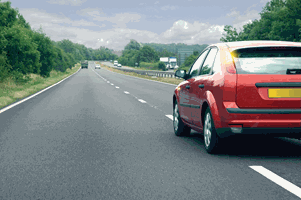
B
C
D
Correct Answer: B
Explanation: There are times when other drivers make incorrect or ill-judged decisions. Be tolerant and try not to retaliate or react aggressively. Always consider the safety of other road users, your passengers and yourself.
Explanation: There are times when other drivers make incorrect or ill-judged decisions. Be tolerant and try not to retaliate or react aggressively. Always consider the safety of other road users, your passengers and yourself.
25. You're waiting in a traffic queue at night. How can you avoid dazzling drivers behind you?
Mark one answer
B
C
D
Correct Answer: D
Explanation: In queuing traffic, your brake lights can dazzle drivers behind you. If you apply your parking brake, you can take your foot off the footbrake. This will turn off the brake lights so that they can't dazzle the driver behind you.
Explanation: In queuing traffic, your brake lights can dazzle drivers behind you. If you apply your parking brake, you can take your foot off the footbrake. This will turn off the brake lights so that they can't dazzle the driver behind you.
26. You're driving in traffic at the speed limit for the road. What should you do if the driver behind is trying to overtake?
Mark one answer
B
C
D
Correct Answer: B
Explanation: Keep a steady course to give the driver behind an opportunity to overtake safely. If necessary, slow down. Reacting incorrectly to another driver's impatience can lead to danger.
Explanation: Keep a steady course to give the driver behind an opportunity to overtake safely. If necessary, slow down. Reacting incorrectly to another driver's impatience can lead to danger.
Correct Answer: A
Explanation: Bus-lane signs show the vehicles allowed to use the lane and its times of operation. Where no times are shown, the bus lane is in operation 24 hours a day.
Explanation: Bus-lane signs show the vehicles allowed to use the lane and its times of operation. Where no times are shown, the bus lane is in operation 24 hours a day.
Correct Answer: C
Explanation: If someone in charge of animals asks you to stop, you should do so and switch off your engine. Animals are unpredictable and startle easily; they could turn and run into your path or into the path of another moving vehicle.
Explanation: If someone in charge of animals asks you to stop, you should do so and switch off your engine. Animals are unpredictable and startle easily; they could turn and run into your path or into the path of another moving vehicle.
Correct Answer: C
Explanation: Horses can be startled by the sound of a car engine or the rush of air caused by a vehicle passing too closely. Keep well back and only pass when it's safe. Leave them plenty of room; you may have to use the other side of the road to go past safely.
Explanation: Horses can be startled by the sound of a car engine or the rush of air caused by a vehicle passing too closely. Keep well back and only pass when it's safe. Leave them plenty of room; you may have to use the other side of the road to go past safely.
30. You're approaching a zebra crossing. What should you do if pedestrians are waiting to cross?
Mark one answer
B
C
D
Correct Answer: B
Explanation: As you approach a zebra crossing, look for pedestrians waiting to cross. Where you can see them, slow down and prepare to stop. Be especially careful of children and older people, who may have difficulty judging when it's safe to cross.
Explanation: As you approach a zebra crossing, look for pedestrians waiting to cross. Where you can see them, slow down and prepare to stop. Be especially careful of children and older people, who may have difficulty judging when it's safe to cross.
Correct Answer: C
Explanation: Try to anticipate what other drivers might do. Look and plan ahead so that you're ready to respond safely if a hazard develops. Be tolerant of road users who make mistakes.
Explanation: Try to anticipate what other drivers might do. Look and plan ahead so that you're ready to respond safely if a hazard develops. Be tolerant of road users who make mistakes.
32. You're approaching a red light at a puffin crossing. Pedestrians are on the crossing. When will the red light change?
Mark one answer
B
C
D
Correct Answer: B
Explanation: A sensor will automatically detect that the pedestrians have reached a safe position. Don't drive on until the green light shows and it's safe for you to do so.
Explanation: A sensor will automatically detect that the pedestrians have reached a safe position. Don't drive on until the green light shows and it's safe for you to do so.
33. Which instrument-panel warning light would show that headlights are on main beam?
Mark one answer
B
C
D
Correct Answer: A
Explanation: You should be aware of all the warning lights and visual aids on the vehicle you're driving. If you're driving a vehicle for the first time, you should familiarise yourself with all the controls, warning lights and visual aids before you set off.
Explanation: You should be aware of all the warning lights and visual aids on the vehicle you're driving. If you're driving a vehicle for the first time, you should familiarise yourself with all the controls, warning lights and visual aids before you set off.
34. When should you leave a two-second gap between your vehicle and the one in front?
Mark one answer
B
C
D
Correct Answer: A
Explanation: In good, dry conditions, a driver needs to keep a distance of at least two seconds from the car in front. This should allow enough space for you to stop if the driver in front has to stop suddenly.
Explanation: In good, dry conditions, a driver needs to keep a distance of at least two seconds from the car in front. This should allow enough space for you to stop if the driver in front has to stop suddenly.
35. You're driving at night on an unlit road. What should you do if you're following another vehicle?
Mark one answer
B
C
D
Correct Answer: C
Explanation: If you follow another vehicle with your headlights on full beam, they could dazzle the driver. Leave a safe distance and make sure that the light from your dipped beam falls short of the vehicle in front.
Explanation: If you follow another vehicle with your headlights on full beam, they could dazzle the driver. Leave a safe distance and make sure that the light from your dipped beam falls short of the vehicle in front.
36. What should you do if you're driving a slow-moving vehicle on a narrow winding road?
Mark one answer
B
C
D
Correct Answer: C
Explanation: If you're driving a slow-moving vehicle along a narrow road, try not to hold up faster traffic. If you see vehicles following behind, pull over in a safe place and let the traffic pass before continuing. Don't wave other traffic past - this could be dangerous if you or they haven't noticed a hazard ahead.
Explanation: If you're driving a slow-moving vehicle along a narrow road, try not to hold up faster traffic. If you see vehicles following behind, pull over in a safe place and let the traffic pass before continuing. Don't wave other traffic past - this could be dangerous if you or they haven't noticed a hazard ahead.
37. You're driving a car that has a diesel engine. What can a loose filler cap on your fuel tank cause?
Mark one answer
B
C
D
Correct Answer: D
Explanation: Diesel fuel can spill out if your filler cap isn't secured properly. This is most likely to occur on bends, junctions and roundabouts, where it will make the road slippery, especially if it's wet. At the end of a spell of dry weather, road surfaces may be especially slippery where diesel has been spilled but it hasn't been washed away by rain.
Explanation: Diesel fuel can spill out if your filler cap isn't secured properly. This is most likely to occur on bends, junctions and roundabouts, where it will make the road slippery, especially if it's wet. At the end of a spell of dry weather, road surfaces may be especially slippery where diesel has been spilled but it hasn't been washed away by rain.
Correct Answer: B
Explanation: When learning to drive, it's a good idea to practise filling your car with fuel. Ask your instructor if you can use a petrol station and fill the fuel tank yourself. You need to know where the filler cap is on the car you're driving, so you know which side of the pump to park at. Take care not to overfill the tank and make sure you secure the filler cap correctly, so that no fuel leaks onto the road while you're driving.
Explanation: When learning to drive, it's a good idea to practise filling your car with fuel. Ask your instructor if you can use a petrol station and fill the fuel tank yourself. You need to know where the filler cap is on the car you're driving, so you know which side of the pump to park at. Take care not to overfill the tank and make sure you secure the filler cap correctly, so that no fuel leaks onto the road while you're driving.
Correct Answer: A
Explanation: Competitive driving increases the risks to everyone and is the opposite of responsible, considerate and defensive driving. Defensive driving is about questioning the actions of other road users and being prepared for the unexpected. Don't be taken by surprise.
Explanation: Competitive driving increases the risks to everyone and is the opposite of responsible, considerate and defensive driving. Defensive driving is about questioning the actions of other road users and being prepared for the unexpected. Don't be taken by surprise.



